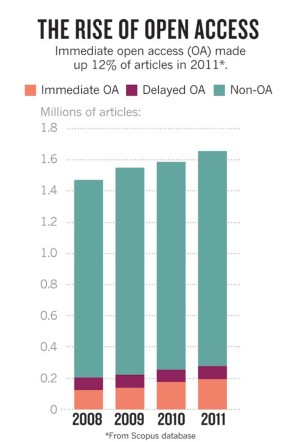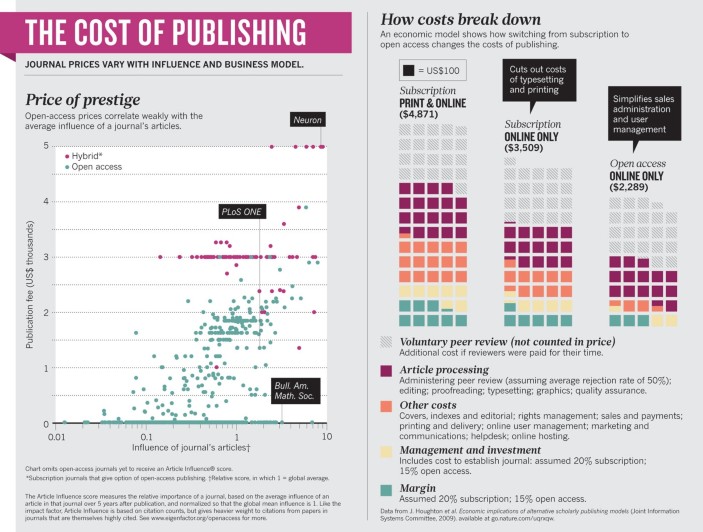Cheap open-access journals raise questions about the value publishers add for their money.

Michael Eisen doesn't hold back when invited to vent. “It's still ludicrous how much it costs to publish research — let alone what we pay,” he declares. The biggest travesty, he says, is that the scientific community carries out peer review — a major part of scholarly publishing — for free, yet subscription-journal publishers charge billions of dollars per year, all told, for scientists to read the final product. “It's a ridiculous transaction,” he says.
Eisen, a molecular biologist at the University of California, Berkeley, argues that scientists can get much better value by publishing in open-access journals, which make articles free for everyone to read and which recoup their costs by charging authors or funders. Among the best-known examples are journals published by the Public Library of Science (PLoS), which Eisen co-founded in 2000. “The costs of research publishing can be much lower than people think,” agrees Peter Binfield, co-founder of one of the newest open-access journals, PeerJ, and formerly a publisher at PLoS.
But publishers of subscription journals insist that such views are misguided — born of a failure to appreciate the value they add to the papers they publish, and to the research community as a whole. They say that their commercial operations are in fact quite efficient, so that if a switch to open-access publishing led scientists to drive down fees by choosing cheaper journals, it would undermine important values such as editorial quality.
These charges and counter-charges have been volleyed back and forth since the open-access idea emerged in the 1990s, but because the industry's finances are largely mysterious, evidence to back up either side has been lacking. Although journal list prices have been rising faster than inflation, the prices that campus libraries actually pay to buy journals are generally hidden by the non-disclosure agreements that they sign. And the true costs that publishers incur to produce their journals are not widely known.
The past few years have seen a change, however. The number of open-access journals has risen steadily, in part because of funders' views that papers based on publicly funded research should be free for anyone to read. By 2011, 11% of the world's articles were being published in fully open-access journals1 (see 'The rise of open access'). Suddenly, scientists can compare between different publishing prices. A paper that costs US$5,000 for an author to publish in Cell Reports, for example, might cost just $1,350 to publish in PLoS ONE — whereas PeerJ offers to publish an unlimited number of papers per author for a one-time fee of $299. “For the first time, the author can evaluate the service that they're getting for the fee they're paying,” says Heather Joseph, executive director of the Scholarly Publishing and Academic Resources Coalition in Washington DC.

The variance in prices is leading everyone involved to question the academic publishing establishment as never before. For researchers and funders, the issue is how much of their scant resources need to be spent on publishing, and what form that publishing will take. For publishers, it is whether their current business models are sustainable — and whether highly selective, expensive journals can survive and prosper in an open-access world.
The cost of publishing
Data from the consulting firm Outsell in Burlingame, California, suggest that the science-publishing industry generated $9.4 billion in revenue in 2011 and published around 1.8 million English-language articles — an average revenue per article of roughly $5,000. Analysts estimate profit margins at 20–30% for the industry, so the average cost to the publisher of producing an article is likely to be around $3,500–4,000.
Most open-access publishers charge fees that are much lower than the industry's average revenue, although there is a wide scatter between journals. The largest open-access publishers — BioMed Central and PLoS — charge $1,350–2,250 to publish peer-reviewed articles in many of their journals, although their most selective offerings charge $2,700–2,900. In a survey published last year2, economist Bo-Christer Björk of the Hanken School of Economics in Helsinki and psychologist David Solomon of Michigan State University in East Lansing looked at 100,697 articles published in 1,370 fee-charging open-access journals active in 2010 (about 40% of the fully open-access articles in that year), and found that charges ranged from $8 to $3,900. Higher charges tend to be found in 'hybrid' journals, in which publishers offer to make individual articles free in a publication that is otherwise paywalled (see 'Price of prestige'). Outsell estimates that the average per-article charge for open-access publishers in 2011 was $660.

Although these fees seem refreshingly transparent, they are not the only way that open-access publishers can make money. As Outsell notes, the $660 average, for example, does not represent the real revenue collected per paper: it includes papers published at discounted or waived fees, and does not count cash from the membership schemes that some open-access publishers run in addition to charging for articles. Frequently, small open-access publishers are also subsidized, with universities or societies covering the costs of server hosting, computers and building space. That explains why many journals say that they can offer open access for nothing. One example is Acta Palaeontologica Polonica, a respected open-access palaeontology journal, the costs of which are mostly covered by government subsidies to the Institute of Paleobiology of the Polish Academy of Sciences in Warsaw; it charges nothing for papers under 10 pages. Another is eLife, which is covered by grants from the Wellcome Trust in London; the Max Planck Society in Munich, Germany; and the Howard Hughes Medical Institute in Chevy Chase, Maryland. And some publishers use sets of journals to cross-subsidize each other: for example, PLoS Biology and PLoS Medicine receive subsidy from PLoS ONE, says Damian Pattinson, editorial director at PLoS ONE.
Neither PLoS nor BioMed Central would discuss actual costs (although both organizations are profitable as a whole), but some emerging players who did reveal them for this article say that their real internal costs are extremely low. Paul Peters, president of the Open Access Scholarly Publishing Association and chief strategy officer at the open-access publisher Hindawi in Cairo, says that last year, his group published 22,000 articles at a cost of $290 per article. Brian Hole, founder and director of the researcher-led Ubiquity Press in London, says that average costs are £200 (US$300). And Binfield says that PeerJ's costs are in the “low hundreds of dollars” per article.
The picture is also mixed for subscription publishers, many of which generate revenue from a variety of sources — libraries, advertisers, commercial subscribers, author charges, reprint orders and cross-subsidies from more profitable journals. But they are even less transparent about their costs than their open-access counterparts. Most declined to reveal prices or costs when interviewed for this article.
The few numbers that are available show that costs vary widely in this sector, too. For example, Diane Sullenberger, executive editor for Proceedings of the National Academy of Sciences in Washington DC, says that the journal would need to charge about $3,700 per paper to cover costs if it went open-access. But Philip Campbell, editor-in-chief of Nature, estimates his journal's internal costs at £20,000–30,000 ($30,000–40,000) per paper. Many publishers say they cannot estimate what their per-paper costs are because article publishing is entangled with other activities. (Science, for example, says that it cannot break down its per-paper costs; and that subscriptions also pay for activities of the journal's society, the American Association for the Advancement of Science in Washington DC.)
Scientists pondering why some publishers run more expensive outfits than others often point to profit margins. Reliable numbers are hard to come by: Wiley, for example, used to report 40% in profits from its scientific, technical and medical (STM) publishing division before tax, but its 2013 accounts noted that allocating to science publishing a proportion of 'shared services' — costs of distribution, technology, building rents and electricity rates — would halve the reported profits. Elsevier's reported margins are 37%, but financial analysts estimate them at 40–50% for the STM publishing division before tax. (Nature says that it will not disclose information on margins.) Profits can be made on the open-access side too: Hindawi made 50% profit on the articles it published last year, says Peters.
Commercial publishers are widely acknowledged to make larger profits than organizations run by academic institutions. A 2008 study by London-based Cambridge Economic Policy Associates estimated margins at 20% for society publishers, 25% for university publishers and 35% for commercial publishers3. This is an irritant for many researchers, says Deborah Shorley, scholarly communications adviser at Imperial College London — not so much because commercial profits are larger, but because the money goes to shareholders rather than being ploughed back into science or education.
But the difference in profit margins explains only a small part of the variance in per-paper prices. One reason that open-access publishers have lower costs is simply that they are newer, and publish entirely online, so they don't have to do print runs or set up subscription paywalls (see 'How costs break down'). Whereas small start-ups can come up with fresh workflows using the latest electronic tools, some established publishers are still dealing with antiquated workflows for arranging peer review, typesetting, file-format conversion and other chores. Still, most older publishers are investing heavily in technology, and should catch up eventually.
Costly functions
The publishers of expensive journals give two other explanations for their high costs, although both have come under heavy fire from advocates of cheaper business models: they do more and they tend to be more selective. The more effort a publisher invests in each paper, and the more articles a journal rejects after peer review, the more costly is each accepted article to publish.
Publishers may administer the peer-review process, which includes activities such as finding peer reviewers, evaluating the assessments and checking manuscripts for plagiarism. They may edit the articles, which includes proofreading, typesetting, adding graphics, turning the file into standard formats such as XML and adding metadata to agreed industry standards. And they may distribute print copies and host journals online. Some subscription journals have a large staff of full-time editors, designers and computer specialists. But not every publisher ticks all the boxes on this list, puts in the same effort or hires costly professional staff for all these activities. For example, most of PLoS ONE's editors are working scientists, and the journal does not perform functions such as copy-editing. Some journals, including Nature, also generate additional content for readers, such as editorials, commentary articles and journalism (including the article you are reading). “We get positive feedback about our editorial process, so in our experience, many scientists do understand and appreciate the value that this adds to their paper,” says David Hoole, marketing director at Nature Publishing Group.
The costs of research publishing can be much lower than people think.
The key question is whether the extra effort adds useful value, says Timothy Gowers, a mathematician at the University of Cambridge, UK, who last year led a revolt against Elsevier (see Nature http://doi.org/kwd; 2012 ). Would scientists' appreciation for subscription journals hold up if costs were paid for by the authors, rather than spread among subscribers? “If you see it from the perspective of the publisher, you may feel quite hurt,” says Gowers. “You may feel that a lot of work you put in is not really appreciated by scientists. The real question is whether that work is needed, and that's much less obvious.”
Many researchers in fields such as mathematics, high-energy physics and computer science do not think it is. They post pre- and post-reviewed versions of their work on servers such as arXiv — an operation that costs some $800,000 a year to keep going, or about $10 per article. Under a scheme of free open-access 'Episciences' journals proposed by some mathematicians this January, researchers would organize their own system of community peer review and host research on arXiv, making it open for all at minimal cost (see Nature http://doi.org/kwg; 2013 ).
These approaches suit communities that have a culture of sharing preprints, and that either produce theoretical work or see high scrutiny of their experimental work — so it is effectively peer reviewed before it even gets submitted to a publisher. But they find less support elsewhere — in the highly competitive biomedical fields, for instance, researchers tend not to publish preprints for fear of being scooped and they place more value on formal (journal-based) peer review. “If we have learned anything in the open-access movement, it's that not all scientific communities are created the same: one size doesn't fit all,” says Joseph.
The value of rejection
Tied into the varying costs of journals is the number of articles that they reject. PLoS ONE (which charges authors $1,350) publishes 70% of submitted articles, whereas Physical Review Letters (a hybrid journal that has an optional open-access charge of $2,700) publishes fewer than 35%; Nature published just 8% in 2011.
The connection between price and selectivity reflects the fact that journals have functions that go beyond just publishing articles, points out John Houghton, an economist at Victoria University in Melbourne, Australia. By rejecting papers at the peer-review stage on grounds other than scientific validity, and so guiding the papers into the most appropriate journals, publishers filter the literature and provide signals of prestige to guide readers' attention. Such guidance is essential for researchers struggling to identify which of the millions of articles published each year are worth looking at, publishers argue — and the cost includes this service.
A more-expensive, more-selective journal should, in principle, generate greater prestige and impact. Yet in the open-access world, the higher-charging journals don't reliably command the greatest citation-based influence, argues Jevin West, a biologist at the University of Washington in Seattle. Earlier this year, West released a free tool that researchers can use to evaluate the cost-effectiveness of open-access journals (see Nature http://doi.org/kwh; 2013 ).
And to Eisen, the idea that research is filtered into branded journals before it is published is not a feature but a bug: a wasteful hangover from the days of print. Rather than guiding articles into journal 'buckets', he suggests, they could be filtered after publication using metrics such as downloads and citations, which focus not on the antiquated journal, but on the article itself (see page 437).
Alicia Wise, from Elsevier, doubts that this could replace the current system: “I don't think it's appropriate to say that filtering and selection should only be done by the research community after publication,” she says. She argues that the brands, and accompanying filters, that publishers create by selective peer review add real value, and would be missed if removed entirely.
PLoS ONE supporters have a ready answer: start by making any core text that passes peer review for scientific validity alone open to everyone; if scientists do miss the guidance of selective peer review, then they can use recommendation tools and filters (perhaps even commercial ones) to organize the literature — but at least the costs will not be baked into pre-publication charges.
These arguments, Houghton says, are a reminder that publishers, researchers, libraries and funders exist in a complex, interdependent system. His analyses, and those by Cambridge Economic Policy Associates, suggest that converting the entire publishing system to open access would be worthwhile even if per-article-costs remained the same — simply because of the time that researchers would save when trying to access or read papers that were no longer lodged behind paywalls.
The path to open access
But a total conversion will be slow in coming, because scientists still have every economic incentive to submit their papers to high-prestige subscription journals. The subscriptions tend to be paid for by campus libraries, and few individual scientists see the costs directly. From their perspective, publication is effectively free.
Of course, many researchers have been swayed by the ethical argument, made so forcefully by open-access advocates, that publicly funded research should be freely available to everyone. Another important reason that open-access journals have made headway is that libraries are maxed out on their budgets, says Mark McCabe, an economist at the University of Michigan in Ann Arbor. With no more library cash available to spend on subscriptions, adopting an open-access model was the only way for fresh journals to break into the market. New funding-agency mandates for immediate open access could speed the progress of open-access journals. But even then the economics of the industry remain unclear. Low article charges are likely to rise if more-selective journals choose to go open access. And some publishers warn that shifting the entire system to open access would also increase prices because journals would need to claim all their revenue from upfront payments, rather than from a variety of sources, such as secondary rights. “I've worked with medical journals where the revenue stream from secondary rights varies from less than 1% to as much as one-third of total revenue,” says David Crotty of Oxford University Press, UK.
Some publishers may manage to lock in higher prices for their premium products, or, following the successful example of PLoS, large open-access publishers may try to cross-subsidize high-prestige, selective, costly journals with cheaper, high-throughput journals. Publishers who put out a small number of articles in a few mid-range journals may be in trouble under the open-access model if they cannot quickly reduce costs. “In the end,” says Wim van der Stelt, executive vice president at Springer in Doetinchem, the Netherlands, “the price is set by what the market wants to pay for it.”
In theory, an open-access market could drive down costs by encouraging authors to weigh the value of what they get against what they pay. But that might not happen: instead, funders and libraries may end up paying the costs of open-access publication in place of scientists — to simplify the accounting and maintain freedom of choice for academics. Joseph says that some institutional libraries are already joining publisher membership schemes in which they buy a number of free or discounted articles for their researchers. She worries that such behaviour might reduce the author's awareness of the price being paid to publish — and thus the incentive to bring costs down.
And although many see a switch to open access as inevitable, the transition will be gradual. In the United Kingdom, portions of grant money are being spent on open access, but libraries still need to pay for research published in subscription journals. In the meantime, some scientists are urging their colleagues to deposit any manuscripts they publish in subscription journals in free online repositories. More than 60% of journals already allow authors to self-archive content that has been peer-reviewed and accepted for publication, says Stevan Harnad, a veteran open-access campaigner and cognitive scientist at the University of Quebec in Montreal, Canada. Most of the others ask authors to wait for a time (say, a year), before they archive their papers. However, the vast majority of authors don't self-archive their manuscripts unless prompted by university or funder mandates.
As that lack of enthusiasm demonstrates, the fundamental force driving the speed of the move towards full open access is what researchers — and research funders — want. Eisen says that although PLoS has become a success story — publishing 26,000 papers last year — it didn't catalyse the industry to change in the way that he had hoped. “I didn't expect publishers to give up their profits, but my frustration lies primarily with leaders of the science community for not recognizing that open access is a perfectly viable way to do publishing,” he says.
Change history
26 June 2013
The scale on the y-axis of ‘The rise of open access’ was originally mislabelled. This has now been corrected.
05 April 2013
This article originally described David Solomon as an economist; he is a psychologist. It also wrongly defined STM as ‘science, technology and mathematics’ instead of ‘scientific, technical and medical’. These errors have been corrected.
References
Laakso, M. & Björk, B.-C. BMC Medicine 10, 124 (2012).
Solomon, D. J. & Björk, B.-C. J. Am. Soc. Inf. Sci. Technol. 63, 1485–1495 (2012).
Cambridge Economic Policy Associates Activities, costs and funding flows in the scholarly communications system in the UK (Research Information Network, 2008).
Additional information
Related links
Related links
Related links in Nature Research
The future of publishing: A new page 2013-Mar-27
Price doesn't always buy prestige in open access 2013-Jan-22
Britain aims for broad open access 2012-Jun-19
Open access comes of age 2011-Jun-21
Nature special: The future of publishing
Related external links
Cost-effectiveness for open-access journals
A study of open-access journals using article-processing charges
Economic implications of alternative scholarly publishing models: exploring the costs and benefits
Rights and permissions
About this article
Cite this article
Van Noorden, R. Open access: The true cost of science publishing. Nature 495, 426–429 (2013). https://doi.org/10.1038/495426a
Published:
Issue Date:
DOI: https://doi.org/10.1038/495426a
This article is cited by
-
Scientific sinkhole: estimating the cost of peer review based on survey data with snowball sampling
Research Integrity and Peer Review (2023)
-
What senior academics can do to support reproducible and open research: a short, three-step guide
BMC Research Notes (2022)
-
Joining the meta-research movement: A bibliometric case study of the journal Perspectives on Medical Education
Perspectives on Medical Education (2022)
-
Higher Author Fees in Gastroenterology Journals Are Not Associated with Faster Processing Times or Higher Impact
Digestive Diseases and Sciences (2022)
-
Microwave effect: analyzing citations from classic theories and their reinventions—a case study from a classic paper in aquatic ecology—Brooks & Dodson, 1965
Scientometrics (2022)

